The Museum Collections
Introduction
I. History and Art Collection
1. Icons of the 14th – 19th centuries
icons of the 14th – 17th century
2. Jewelry art of the 14th – 20th century
jewelry art of the 14th – 17th century
jewelry art of the 18th – 19th century
the european silver 14th - 19th centuries
3. Small-size sculptures (works of metal, wood, bone)
XI – the beginning of the XX century
Small-size sculptures 11th – 17th century
Small-size sculptures 18th – early 20th century
enamel of Troitza masters 15-8th – early 20th century
5.Embroidery, lace, textiles of the 14th - early 20th century
icon and ornamental embroidery
gold and silver lace
6.Painting of the 18th – 21st centuries
painting of the 18th – 19th centuris
painting of the 20th – 21st centuris
II.Manuscripts and old printed books of the 14th – 17th century
IV.Lithography of the 18th – 19th century
V.Numismatics
VI.Medals of the 18th - early 20th century
VIII.Archeology collection
IX. Russian folk and applied and decorative art of the 17th – 21st c.
1. Artistic wood
folk carved and painted wood
wooden toys
house carving of Sergiev Posad
Khokhloma and Gorodets painting
2. Artistic textiles
embroidery and weaving
printed textiles and lace
Russian shawls
folk costumes
folk garments
printed cotton kerchiefs
|
Icons of the 14th – 17th cc. (page 3)
|
|
In the 16th century multifigured compositions were very popular. “The Exaltation of the Cross” is a characteristic work of that time. The icon originated from the wooden church of Vozdvizhenskoye village, situated not far from the Monastery on the ancient pilgrimage route of Moscow tsars. The small icon “The Nativity of the Virgin” belongs to the same multifigured type. “The Assumption of the Virgin”, probably painted by a Tver artist, is rather narrative and illustrative, corresponding to the 16th century Russian icon-painting. This icon originated from the Church of Intercession of Volokolamsk. Previously it used to belong to the Assumption Cathedral of St. Barbara Monastery.
|
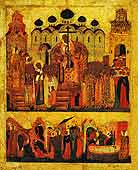
The Exaltation of the Cross. 16th century |
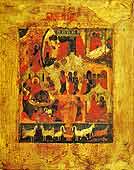
The Nativity of the Virgin. 16th century |
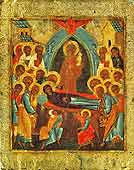
The Assumption of the Virgin. From the Church
of Intercession of Volokolamsk. 16th ccentury |
The formal qualities of many 16th century icons are very high and sometimes perfect. Two icons: “St. Nicholas” and “St. John the Baptist as Angel of the Wilderness”- are splendid. They evidently were hinged sections of some icon case. In the 17th century they were in the iconostasis of the Trinity Cathedral.
“St. Nicholas of Mozhaisk” is another interesting work.. The great popularity of St. Nicholas in Russia resulted in development of purely Russian iconographies of this Byzantine saint. A legend of a miraculous salvation of Mozhaisk from tartars, when St. Nicholas appeared to the inhabitants with a sword and a town in his hands, was a basis for the image of St. Nicholas of Mozhaisk. A considerable group of icons, painted by the local Trinity artists, is significant in the 16th century collection. The earliest icon in this group is “St. Xenia and the Scenes from Her Life”, painted by an undoubtedly talented artist.
|

St. Nicholas. 16th century |

St. John the Baptist as Angel of the Wilderness. 16th century |
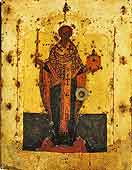
St. Nicholas of Mozhaisk. Family icon of the Voitegoviches. 16th century |
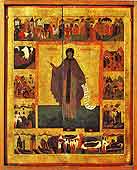
St. Xenia and the Scenes from Her Life. 1551. Donated by Princess Kilikia Ushataya
|
David Syrakh was presumably a Trinity icon-painter. His name is written on the icon “The Virgin of Vladimir”, painted in 1571. Interesting Trinity icons of the last decade of the 16th century are connected with the Monastery cellarer Eustathius Golovkin. He was the Monastery cellarer in 1571 – 1581 and in 1583 – 1593. A person of great organizing ability and authority, he was highly respected by Russian tsars and took part in political life of the country.
In 1588 Eustathius Golovkin has written "The Appearance of the Virgin to St. Sergius of Radonezh " - the central part of a known triptych, on which narrow shutters are represented (probably, other artist) outside - John Baptist and St.Nicholas, inside - archangel Michael and the Guardian angel. The "St. Sergius of Radonezh and the Scenes from His Life" (the other work of art) Eustathius Golovkin has written three years later, in 1591. The Sample for it was the similar image of the end XV - the beginnings of XVI century from an iconostasis of the Troitsk cathedral. Most likely, the icon "St. Nicholas with the Trinity and the elite sacred" has written by the Troitsk master.
|
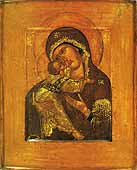
David Syrakh. The Virgin of Vladimir. !6th century |
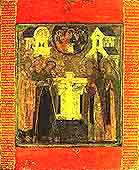
Eustathius Golovkin. The Appearance of the Virgin to St. Sergius of Radonezh. Folding icon. 1588. Central part |
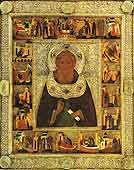
Eustathius Golovkin. St. Sergius of Radonezh and the Scenes from His Life. 1591 |
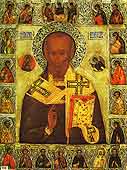
St. Nicholas, the Holy Trinity and Selected Saints
|
In Moscow icon-painting of the late 16th – early 17th century there were two prominent trends conventionally called “Godunov” and “Stroganov” painting. The names were the more conventional, when the same icon-painters were commissioned by the Godunovs, Stroganovs and Romanovs. The hinged sections of the icon-case for the icon by Andrei Rublev “The Trinity of Old Testament” were commissioned by Boris Godunov in 1601. There are four high, narrow panels connected by pairs. In twenty fragments the Bible story of the “deeds” of the Holy Trinity are depicted in a vivid, amusing and narrative manner.
One of the best examples of “Stroganov” painting in the Museum collection is the folding iconostasis donated to the Trinity Monastery in memory of Duma deacon Ivan Tarasievich Gramotin. Painted on twenty eight narrow panels, each separated in three parts, the folding iconostasis presents a miniature iconostasis with three classic ranges: Deesis, Festivities and Prophets.
|

Deeds of the Holy Trinity. Hinged sections of the icon-case. Late 16th century. Detail |

Deeds of the Holy Trinity. Hinged sections of the icon-case. Late 16th century. Detail |
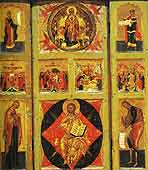
Folding iconostasis. First decade of the 17th century. Folded |
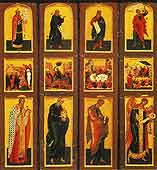
Folding iconostasis. First decade of the 17th century. Detail. |
|


